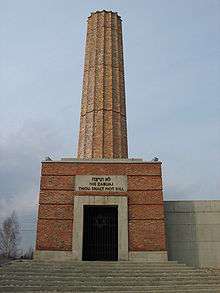Radegast train station

The Radogoszcz station[1][2] (German: Bahnhof Radegast)[3] built originally between 1926 and 1937,[4] is a small historic railway station in Łódź, Poland; also referred to as the loading platform in Marysin, a neighbourhood in the Bałuty district of the city.[1] During World War II the station was situated just beyond the boundary of the Łódź Ghetto – one of the biggest Jewish ghettos in German-occupied Europe. Radegast was the main railway link of the Ghetto to the outside world, used predominantly for the Holocaust transports organized by German Nazis.[3]
In the course of the Holocaust in Poland, the Umschlagplatz at the Radegast station was the place where predominantly Jewish inhabitants of Łódź including thousands of expelees from across occupied Poland were gathered for deportations directly to Chełmno (Kulmhof) and Auschwitz extermination camps.[2] Approximately 200,000 Polish, Austrian, German, Luxemburg and Czech Jews passed through the station on the way to their deaths in the period from January 16, 1942, to August 29, 1944.[5] The collection point had the same significance for Łódź as the better known Umschlagplatz had for the Warsaw Ghetto.
Commemoration
In 2004, the commemoration ceremonies on the sixtieth anniversary of the destruction of the Łódź Ghetto in 1944 and the departure of the last transport from Radegast spurred efforts to transform the former station into a Holocaust memorial.[6] On August 28, 2005, a monument commemorating the Jewish victims who passed through the station was unveiled, based on design by Czesław Bielecki, and featuring the 140 metres (460 ft) Tunnel of the Deported.[7] The renovated station building serves as one of the divisions of the Łódź Museum of Independence.[4]

References
| Wikimedia Commons has media related to Łódź Stacja Radegast. |
- 1 2 Michal Latosinski (2013). "The Radogoszcz (Radegast) Station, or the loading platform at Marysin". The Chronicle of the Lodz Ghetto, July 11, 1942, Vol. 2 by Lucjan Dobroszycki. Litzmannstadt Ghetto. Retrieved 2 December 2013.
- 1 2 Lucjan Dobroszycki (1984). The Chronicle of the Lodz Ghetto, 1941-1944. Yale University Press. pp. 514–515. ISBN 0300039247. Retrieved 2 December 2013.
- 1 2 Horwitz, Gordon J (2008). Ghettostadt: Łódź and the Making of a Nazi City. Harvard University Press. p. 117. ISBN 0-674-02799-X.
- 1 2 "Historia Stacji Radegast". Muzeum Tradycji Niepodległościowych w Łodzi. Retrieved 2 December 2013.
- ↑ "Memorial Radegast station". Centrum Dialogu im. Marka Edelmana w Łodzi. 2013. Retrieved 2 December 2013.
- ↑ Bedford, Neal (2008). Lonely Planet guide to Poland. Lonely Planet. p. 126. ISBN 1-74104-479-0.
- ↑ "Stacja Radegast Litzmanntastadt Getto 1940-1944". Muzeum Tradycji Niepodległościowych w Łodzi. 2013. Retrieved 2 December 2013.
Coordinates: 51°48′08″N 19°28′48″E / 51.80214°N 19.480133°E